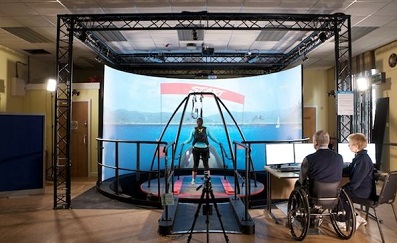CBIT blog: “Acquired brain injury, isolation and the role of technology”
News
The Child Brain Injury Trust (CBIT) have shared an insightful and inspiring series of blogs entitled “Feeling at home in your body: acquired brain injury, isolation and the role of technology.”
In the series you can see the state-of-the-art facilities at the Brain and Spinal Injury Centre (BASIC) featured.
Read part one here and read part two here.
Mike Greaney, neuro-physiotherapist and a lecturer in physiotherapy at the University Of Central Lancashire, writes: “Rehabilitation is difficult. Particularly after a brain injury. But it doesn’t always have to be… With the correct application of a well-researched and technology-led rehabilitation programme, a young person’s rehabilitation journey can be purposeful and enjoyable!”
Mike takes you through how you can best find a technology that meets your needs, and how a rehabilitation ‘mindset’ can help you get the best results from using the technology of your choice.
Here are a few things to keep in mind:
- There are no shortcuts to recovery; just well applied, bespoke treatment.
- Decide your goals and communicate what are your hopes and expectations early in your rehabilitation journey.
- Think about which type of technology could be effective for you BUT take advice from a trusted source.
- Rehabilitation isn’t something that is done to you, it’s something you must be engaged with and take ownership of…
- Physical and cognitive recovery after a brain injury is difficult. It is important to get the right intensity of treatment and know when to push yourself.
- Take ownership of your physicality – the recovery process needs to have a purpose, otherwise, it could feel like constant hard work.
“It is important to find a technology that not only helps you to achieve your goals, but also one which also brings you some pleasure whilst you are doing it! Let’s be honest, it’s rare to find a person who is 100% motivated when it comes to their fitness, and who always enjoys exercising! Part of the rehabilitation journey for a young person with a head injury is having the grit and determination to continue to engage in rehabilitation.”
“What I like about immersive technology is that we can selectively increase the intensity of rehabilitation through very measurable parameters. With immersive technology we can layer in complexities like cognitive loading, executive function tasks and dual tasking, whilst also increasing the physical challenge of a task.“
Mike Greaney is a neuro-physiotherapist and a lecturer in physiotherapy at the University Of Central Lancashire. He takes a clinical interested in integrating technology into neurological rehabilitation. Read part one here and read part two here.

